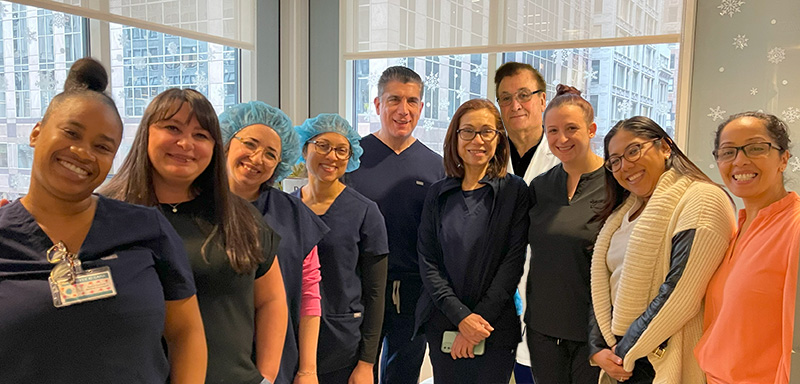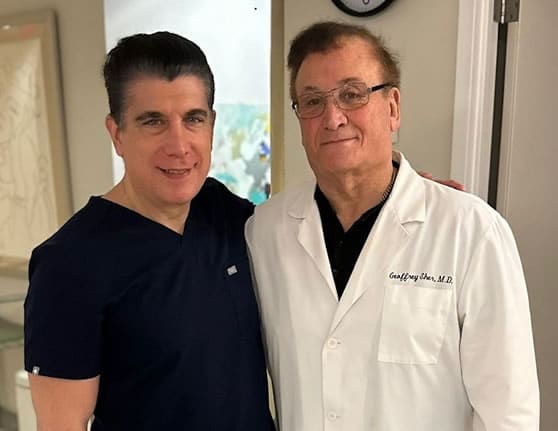Answer: I would not advise using this embryo!
Human embryo development occurs through a process that encompasses reprogramming, sequential cleavage divisions and mitotic chromosome segregation and embryonic genome activation. Chromosomal abnormalities may arise during germ cell and/or preimplantation embryo development and represents a major cause of early pregnancy loss. More than 15 years ago, we were the first to introduce full embryo karyotyping (identification of all 46 chromosomes) through preimplantation genetic sampling (PGS) as a method by which to selectively transfer only euploid embryos (i.e. those that have a full component of chromosomes) to the uterus. We subsequently reported on a 2-3-fold improvement in implantation and birth rates as well as a significant reduction in early pregnancy loss, following IVF. Since then PGS has grown dramatically in popularity such that it is now widely used throughout the world.
Many IVF programs that offer PGS/PGT-A services, require that all participating patients consent to all their aneuploid embryos (i.e. those with an irregular quota of chromosomes) be disposed of. However, a growing body of evidence suggests that following embryo transfer, some aneuploid embryos will in the process of ongoing development, convert to the euploid state (i.e. “autocorrect”) and then go on to develop into chromosomally normal offspring. In fact, I am personally aware of several such cases having occurred in my own practice. So clearly, summarily discarding all aneuploid embryos as a matter of routine we are sometimes destroying some embryos that might otherwise have “autocorrected” and gone on to develop into normal offspring. Thus, by discarding aneuploid embryos the possibility exists that we could be denying some women the opportunity of having a baby. This creates a major ethical and moral dilemma for those of us that provide the option of PGS/PGT-A to our patients. On the one hand, we strive “to avoid knowingly doing harm” (the Hippocratic Oath) and as such would prefer to avoid or minimize the risk of miscarriage and/or chromosomal birth defects and on the other hand we would not wish to deny patients with aneuploid embryos, the opportunity to have a baby.
The basis for such embryo “autocorrection” lies in the fact that some embryos found through PGS/PGT-A-karyotyping to harbor one or more aneuploid cells (blastomeres) will often also harbor chromosomally normal (euploid) cells (blastomeres). The coexistence of both aneuploid and euploid cells coexisting in the same embryo is referred to as “mosaicism.”
It is against this background, that an ever-increasing number of IVF practitioners, rather than summarily discard PGS-identified aneuploid embryos are now choosing to cryobanking (freeze-store) certain of them, to leave open the possibility of ultimately transferring them to the uterus. In order to best understand the complexity of the factors involved in such decision making, it is essential to understand the causes of embryo aneuploidy of which there are two varieties:
- Meiotic aneuploidy” results from aberrations in chromosomal numerical configuration that originate in either the egg (most commonly) and/or in sperm, during preconceptual maturational division (meiosis). Since meiosis occurs in the pre-fertilized egg or in and sperm, it follows that when aneuploidy occurs due to defective meiosis, all subsequent cells in the developing embryo/blastocyst/conceptus inevitably will be aneuploid, precluding subsequent “autocorrection”. Meiotic aneuploidy will thus invariably be perpetuated in all the cells of the embryo as they replicate. It is a permanent phenomenon and is irreversible. All embryos so affected are thus fatally damaged. Most will fail to implant and those that do implant will either be lost in early pregnancy or develop into chromosomally defective offspring (e.g. Down syndrome, Edward syndrome, Turner syndrome).
- Mitotic aneuploidy (“Mosaicism”) occurs when following fertilization and subsequent cell replication (cleavage), some cells (blastomeres) of a meiotically normal (euploid) early embryo mutate and become aneuploid. This is referred to as “mosaicism”. Thereupon, with continued subsequent cell replication (mitosis) the chromosomal make-up (karyotype) of the embryo might either comprise of predominantly aneuploid cells or euploid cells. The subsequent viability or competency of the conceptus will thereupon depend on whether euploid or aneuploid cells predominate. If in such mosaic embryos aneuploid cells predominate, the embryo will be “incompetent”). If (as is frequently the case) euploid cells prevail, the mosaic embryo will likely be “competent” and capable of propagating a normal conceptus.
Since some mitotically aneuploid (“mosaic”) embryos can, and indeed do “autocorrect’ while meiotically aneuploid embryos cannot, it follows that an ability to reliably differentiate between these two varieties of aneuploidy would potentially be of considerable clinical value. The recent introduction of a variety of preimplantation genetic screening (PGS) known as next generation gene sequencing (NGS) has vastly improved the ability to reliably and accurately karyotype embryos and thus to diagnose embryo “mosaicism”.
Most complex aneuploidies are meiotic in origin and will thus almost invariably fail to propagate viable pregnancies. The ability of mosaic embryos to autocorrect is influenced by stage of embryo development in which the diagnosis is made, which chromosomes are affected, whether the aneuploidy involves a single chromosome (simple) or involves 3 or more chromosomes (complex), and the percentage of cells that are aneuploid. Many embryos diagnosed as being mosaic prior to their development into blastocysts (in the cleaved state), subsequently undergo autocorrection to the euploid state (normal numerical chromosomal configuration) as they develop to blastocysts in the Petri dish. This is one reason why “mosaicism” is more commonly detected in early embryos than in blastocysts. Embryos with segmental mosaic aneuploidies, i.e. the addition (duplication) or subtraction (deletion), are also more likely to autocorrect. Finally, the lower the percentage of mitotically aneuploid (mosaic) cells in the blastocyst the greater the propensity for autocorrection and propagation of chromosomally normal (euploid) offspring. A blastocyst with <30% mosaicism could yield a 30% likelihood of a healthy baby rate with 10-15% miscarriage rate, while with >50% mosaicism the baby rate is roughly halved and the miscarriage rate double.
As stated, the transfer of embryos with autosomal meiotic trisomy, will invariably result in failed implantation, early miscarriage or the birth of a defective child. Those with autosomal mitotic (“mosaic”) trisomies, while having the ability to autocorrect in-utero and result in the birth of a healthy baby can, depending on the percentage of mosaic (mitotically aneuploid) cells present, the number of aneuploid chromosomes and the type of mosaicism (single or segmental) either autocorrect and propagate a normal baby, result in failed implantation, miscarry or cause a birth defect (especially with trisomies 13, 18 or 21). This is why when it comes to giving consideration to transferring trisomic embryos, suspected of being “mosaic”, I advise patients to undergo prenatal genetic testing once pregnant and to be willing to undergo termination of pregnancy in the event of the baby being affected. Conversely, when it comes to meiotic autosomal monosomy, there is almost no chance of a viable pregnancy. in most cases implantation will fail to occur and if it does, the pregnancy will with rare exceptions, miscarry. “Mosaic” (mitotically aneuploid) autosomally monosomic embryos where a chromosome is missing), can and often will “autocorrect” in-utero and propagate a viable pregnancy. It is for this reason that I readily recommend the transfer of such embryos, while still (for safety’s sake) advising prenatal genetic testing in the event that a pregnancy results.
What should be done with “mosaic embryos? While the ability to identify “mosaicism” through karyotyping of embryos has vastly improved, it is far from being absolutely reliable. In fact, I personally have witnessed a number of healthy/normal babies born after the transfer of aneuploid embryos, previously reported on as revealing no evidence of “mosaicism”. However, the question arises as to which “mosaic” embryos are capable of autocorrecting in-utero and propagating viable pregnancies. Research suggests that that embryos with autosomal monosomy very rarely will propagate viable pregnancies. Thus, it is in my opinion virtually risk-free to transfer embryos with monosomies involving up to two (2) autosomes. The same applies to the transfer of trisomic embryos where up to 2 autosomes are involved. Only here, there is a risk of birth defects (e.g. trisomy 21/18, etc.) and any resulting pregnancies need to be carefully assessed and if needed/desired, be ended. Regardless, it is essential to make full disclosure to the patient (s), and to ensure the completion of a detailed informed consent agreement which would include a commitment by the patient (s) to undergo prenatal genetic testing (amniocentesis/CVS) aimed at excluding a chromosomal defect in the developing baby and/or a willingness to terminate the pregnancy should a serious birth defect be diagnosed. Blastocysts with aneuploidies involving > 2 autosomes are complex abnormal and should in my opinion, be discarded.
I strongly recommend that you visit www.SherIVF.com. Then go to my Blog and access the “search bar”. Type in the titles of any/all of the articles listed below, one by one. “Click” and you will immediately be taken to those you select. Please also take the time to post any questions or comments with the full expectation that I will (as always) respond promptly.
- A Fresh Look at the Indications for IVF
- The IVF Journey: The importance of “Planning the Trip” Before Taking the Ride”
- Controlled Ovarian Stimulation (COS) for IVF: Selecting the ideal protocol
- IVF: Factors Affecting Egg/Embryo “competency” during Controlled Ovarian Stimulation(COS)
- The Fundamental Requirements For Achieving Optimal IVF Success
- Use of GnRH Antagonists (Ganirelix/Cetrotide/Orgalutron) in IVF-Ovarian Stimulation Protocols.
- Anti Mullerian Hormone (AMH) Measurement to Assess Ovarian Reserve and Design the Optimal Protocol for Controlled Ovarian Stimulation (COS) in IVF.
- Controlled Ovarian Stimulation (COS) in Older women and Women who have Diminished Ovarian Reserve (DOR): A Rational Basis for Selecting a Stimulation Protocol
- Optimizing Response to Ovarian Stimulation in Women with Compromised Ovarian Response to Ovarian Stimulation: A Personal Approach.
- Hereditary Clotting Defects (Thrombophilia)
- Blastocyst Embryo Transfers done 5-6 Days Following Fertilization are Fast Replacing Earlier day 2-3 Transfers of Cleaved Embryos.
- Embryo Transfer Procedure: The “Holy Grail in IVF.
- Timing of ET: Transferring Blastocysts on Day 5-6 Post-Fertilization, Rather Than on Day 2-3 as Cleaved Embryos.
- IVF: Approach to Selecting the Best Embryos for Transfer to the Uterus.
- Fresh versus Frozen Embryo Transfers (FET) Enhance IVF Outcome
- Frozen Embryo Transfer (FET): A Rational Approach to Hormonal Preparation and How new Methodology is Impacting IVF.
- Staggered IVF
- Staggered IVF with PGS- Selection of “Competent” Embryos Greatly Enhances the Utility & Efficiency of IVF.
- Staggered IVF: An Excellent Option When. Advancing Age and Diminished Ovarian Reserve (DOR) Reduces IVF Success Rate
- Embryo Banking/Stockpiling: Slows the “Biological Clock” and offers a Selective Alternative to IVF-Egg Donation
- Preimplantation Genetic Testing (PGS) in IVF: It should be Used Selectively and NOT be Routine.
- IVF: Selecting the Best Quality Embryos to Transfer
- Preimplantation Genetic Sampling (PGS) Using: Next Generation Gene Sequencing (NGS): Method of Choice.
- PGS and Assessment of Egg/Embryo “competency”: How Method, Timing and Methodology Could Affect Reliability
- IVF outcome: How Does Advancing Age and Diminished Ovarian Reserve (DOR) Affect Egg/Embryo “Competency” and How Should the Problem be addressed.
___________________________________________________
ADDENDUM: PLEASE READ!!
INTRODUCING SHER FERTILITY SOLUTIONS (SFS)
Founded in April 2019, Sher Fertility Solutions (SFS) offers online (Skype/FaceTime) consultations to patients from > 40 different countries. All consultations are followed by a detailed written report presenting my personal recommendations for treatment of what often constitute complex Reproductive Issues.
If you wish to schedule an online consultation with me, please contact my assistant (Patti Converse) by phone (800-780-7437/702-533-2691), email (concierge@SherIVF.com) or, enroll online on then home-page of my website (www.SherIVF.com).
PLEASE SPREAD THE WORD ABOUT SFS!
Geoff Sher









